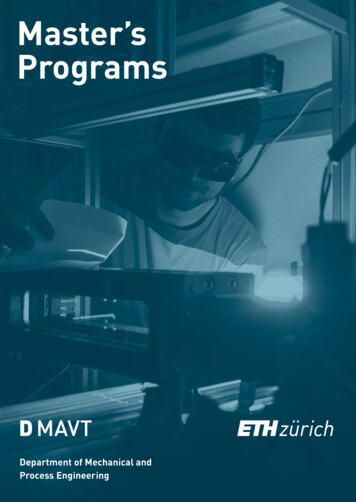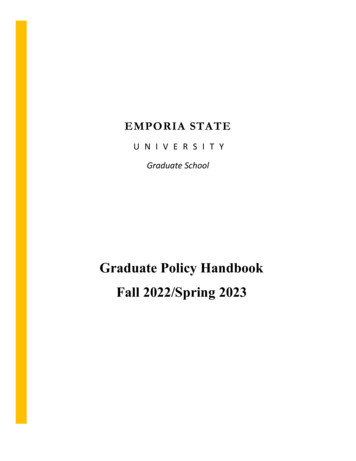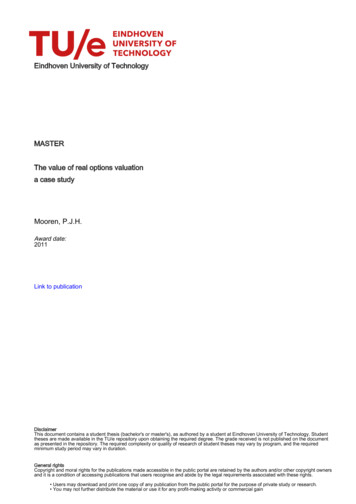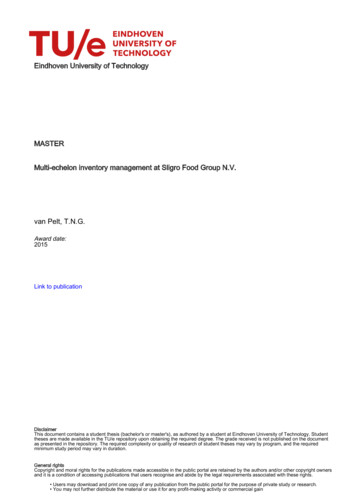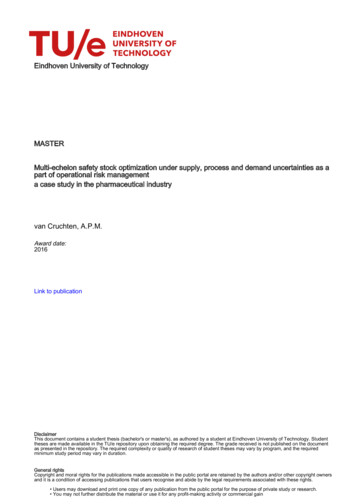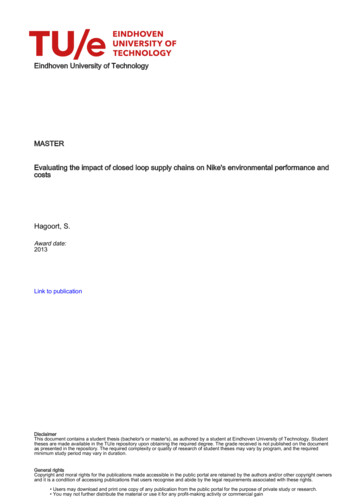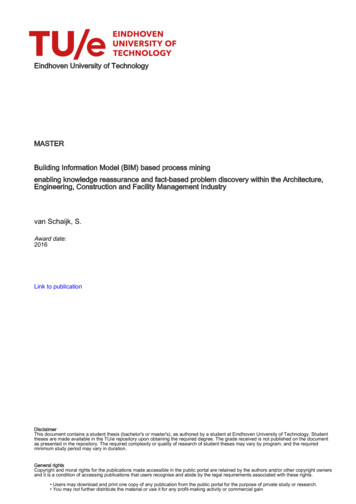
Transcription
Eindhoven University of TechnologyMASTERBuilding Information Model (BIM) based process miningenabling knowledge reassurance and fact-based problem discovery within the Architecture,Engineering, Construction and Facility Management Industryvan Schaijk, S.Award date:2016Link to publicationDisclaimerThis document contains a student thesis (bachelor's or master's), as authored by a student at Eindhoven University of Technology. Studenttheses are made available in the TU/e repository upon obtaining the required degree. The grade received is not published on the documentas presented in the repository. The required complexity or quality of research of student theses may vary by program, and the requiredminimum study period may vary in duration.General rightsCopyright and moral rights for the publications made accessible in the public portal are retained by the authors and/or other copyright ownersand it is a condition of accessing publications that users recognise and abide by the legal requirements associated with these rights. Users may download and print one copy of any publication from the public portal for the purpose of private study or research. You may not further distribute the material or use it for any profit-making activity or commercial gain
ColophonTitle: Building Information Model (BIM) based process miningSubtitle: Enabling knowledge reassurance and fact-based problem discovery within theArchitecture, Engineering, Construction and Facility Management IndustryAuthor:University student number:E-mail:University:Graduation program:S. (Stijn) van Schaijk0856091stijnvanschaijk@gmail.comEindhoven University of TechnologyMaster Construction Management and EngineeringGraduation committee:Prof.dr.ir. B. (Bauke) de VriesUniversity supervisor (chairman graduation committee)b.d.vries@tue.nlDr.dipl.-ing J. (Jakob) BeetzUniversity supervisorj.beetz@tue.nlIr. L.A.H.M. (Léon) van BerloTNO External supervisorLeon.vanberlo@tno.nlThesis defence Date: 01-03-2016This thesis contains several pictures and URLs which are intended for digital usage. The digitalversion of this report can be downloaded via the link or QR-code Version.pdf?dl 0Page 1 of 142
Page 2 of 142
PrefaceI am very proud to present this thesis as a result of my graduation research. The study isdone in collaboration with the Eindhoven University of Technology and the Netherlandsorganization for applied scientific research TNO. I look back at an interesting time with hardwork. I spoke a lot of inspiring people and want to thank all who has helped me during theresearch, among which all who helped me with conducting the case studies within thisresearch.Special thanks go to my university supervisor Jakob Beetz with whom I had a lot ofinteresting meetings and he really helped me defining the roadmap of this study. Infiniteendless everlasting thanks go to my TNO supervisor Léon van Berlo who really guided methroughout the whole research. His advice, visions, network, good sense for coffee andhumour really brought my research to a higher level.Lastly I want to thank my family and my girlfriend for supporting me during my master trackConstruction Management and Engineering at the university. For that I am very thankful.I hope you will enjoy reading this thesis as much as I enjoyed conducting the research.Stijn van SchaijkEindhoven, February 2016Page 3 of 142
Page 4 of 142
Table of contentsSummary . 9Samenvatting . 1112Reading guide. 131.1Chapter classification . 131.2Target group . 14Motivation . 172.132.1.1Problem analysis and research objectives . 202.1.2Problem definition. 202.2Research question(s) . 212.3Research approach . 222.4Expected results. 22Literature review . 253.1The complexity of construction processes . 253.1.2BIM and IT systems adoption in construction . 273.1.3Planning, capturing and monitoring on construction sites . 293.1.4Research gab in construction process planning and monitoring . 35Process mining . 373.2.1Event logs . 383.2.2Bottlenecks . 423.2.3Planning deviation . 433.2.4Organizational mining . 443.2.5Experimental case studies . 453.35Construction process planning and monitoring . 253.1.13.24Problem definition . 20Conclusion construction process mining . 47Proposed workflow BIM based process mining . 494.1Plan . 494.2Capture . 504.3Analyse. 504.4Reuse . 514.5Conclusion and discussion . 51Development of BIM based event log generator . 535.1Desired output . 545.2Input requirements . 555.3Eventlog service in BIMserver . 55Page 5 of 142
675.4Output. 565.5Discussion Eventlog service . 57Development of automated Planning consult . 596.1Desired output . 596.2Input requirements . 606.2.1IFC requirements . 606.2.2Event log requirements . 606.3Planning consult in BIMserver . 606.4Output. 616.5Discussion Planning consult. 62Validation and testing of the developed tools . 637.1Validation of the Eventlog service . 647.1.17.28Validation of the Planning consult . 69Case study construction site process mining . 738.1The project . 738.2Method . 738.3As-planned model generation . 748.3.18.4Discussion as-planned model generation . 75As-built capturing . 758.4.1Point cloud creation with Structure from Motion. 768.4.2As-built scene representation . 778.4.3Comparison as-built point cloud and as-planned IFC . 798.4.4Discussion as-built capturing. 798.5As-planned and as-built analytics . 808.5.1Event log generation. 808.5.2Event log analytics . 828.5.3Discussion analytics . 898.6Reuse of process data . 898.6.1Planning consult . 898.6.2Applications of the Planning consult . 918.6.3Conclusion and discussion reuse . 928.79Multiple event log projects combined . 67Conclusion and discussion case study . 92Conclusions and recommendations . 939.1State-of-the-art . 93Page 6 of 142
9.2Potentials for process mining in the construction industry. 9410Discussion and further research. 9711References . 10112Appendix Case study: Construction design process mining . 10613Appendix Case study: Process mining with facility management data . 12214Appendix Dataset . 13014.1 Dataset Schependomlaan . 13014.1.1Design model . 13014.1.2Coordination model and Subcontractor models . 13114.1.3Planning and as-planned models . 13114.1.4As-built Point clouds . 13414.1.5Comparison as-planned as-built. 13414.1.6Event logs . 13415Appendix Algorithm Eventlog service . 13516Appendix Algorithm Planning consult service. 13717Appendix Planning consult Schependomlaan . 139Page 7 of 142
Page 8 of 142
SummaryResearch among practitioners from the construction industry in the Netherlands has indicatedthat failures in planning, in specific planning deviation, cause failure costs while executing theproject. A realistic planning is suggested as a solution for this problem. The planning is basedon how previous projects are executed and how this process lasted, or the company thinks itwas lasted. To gain insight into how these processes actually proceeded and where bottlenecksoccur projects are being monitored by the construction company. Interviews with practitionersrevealed that these monitoring systems mainly depend on human written notes. It was noticedthat despite the importance, the current practices of monitoring systems are still-timeconsuming, costly and prone to errors. Thereby monitoring is rarely be done and the data isnearly used. This results in feeling based improving instead of fact based problem solvingwithin construction companies.Regarding the requirement to monitor construction processes and the fact that the currentlyused observation tools are inefficient and inaccurate the need for research regarding thisproblem is grounded. Within the research domain of process mining a possible solution forthis problem can be found. Process mining provides an approach to gain insight and improveprocesses in a lot application domains. The goal of process mining is to gain event data, extractprocess-related information stored in event logs and discover a process model. Process miningis all about exploiting event data in a meaningful way in order to provide insights, identifybottlenecks, anticipate problems, record policy violations, recommend countermeasures, andstreamline processes.During the ‘data explosion’ from last decades the capabilities of information systems expandedrapidly. As a result the digital universe and the physical universe are becoming more and morealigned. The growth of the technological possibilities with Radio Frequency Identification(RFID), Global Positioning System (GPS), Intelligent Imaging Camera systems, sensor networksand Internet of Things will stimulate further alignment of the digital and physical universe.Even in the so called ‘old fashioned’ construction industry these new technologies aregradually implemented. Specifically the expansion of the use of Building InformationModelling (BIM) enables the industry to combine those new technologies within the designdatabases. This data explosion development makes it possible to record physical events duringconstruction projects as ‘event logs’ and analyse them digitally.Given (a) the interest in monitoring, observation of construction projects and the interest inconstruction process models, (b) the limited quality of current monitoring and observationtools and the unrealistic hand-made models, and (c) the possibilities to autonomous create,store, and extract event data with new technologies and BIM, it seems legit to study the valueof relating event data to process models. Therefore this research targets on shorteningconstruction projects by discovering bottlenecks with help of process mining and BIM.In order to reach the target of the research state-of-the-art technologies are studied and aworkflow is proposed. The Plan-Capture-Analyse-Reuse workflow enables continuouslylearning loops for contractors. It is seen that BIM based planning tools can be used to makeas-planned models including planned tasks linked to building elements. Several monitoringtechnologies are available to capture the progress and planning deviation on constructionsites. Within the case study executed within this research drone images are used to generatePage 9 of 142
as-built point clouds models which are compared to as-planned BIM models. The deviationsof the as-planned model and as-built process where measured, but no tool which can generateevent logs from those models was available. Event logs are necessary for the analysing phase.By use of the Eventlog service, a software tool which is made within this study, the as-plannedmodel is translated into event logs. The as-built data is merged with those logs resulting in asbuilt event logs. The event log data format enables process mining analytics. It is noticed thatwith process mining tools bottlenecks from the event logs can be discovered. The case studywhich is executed and described during this research proved that it is possible to gain insightin bottlenecks and planning deviation. By use of the Plan-Capture-Analyse-Reuse workflowand several BIM and process mining tools, continuously learning loops for constructioncompanies where realized. As part of this workflow the Planning consult software tool isdeveloped. By use of this tool it is proven that event logs from previous projects can be reusedin order to advice construction planners and identify risks in early phases of new to buildconstruction projects. Thereby it serves as a basis for continuously learning and enablesconstruction project time decrease.Current state-of-the-art technologies regarding planning and monitoring systems forconstruction projects enable to autonomously measure progress. It is recommended tocontractors to implement the concept of process-oriented data warehouse, a databasecontaining information about relevant events happened in the company and his constructionprojects. As-planned BIM models can serve as a solid bases for such warehouses. BIM toolsare able to make as-planned models which are suitable for project scheduling. At this momentas-planned BIM is mainly used on single projects and mainly for visualisation purposes.However companies are not aware of the value of those models and applications andreusability of the accompanied data. With process mining analytics in mind a contractor findsan additional purpose for his as-planned models and records its requirements in the BIMprotocol. The applicability of BIM based process databases in practice is an interesting topicfor further research.Page 10 of 142
SamenvattingOnderzoek in de bouw sector in Nederland heeft aangetoond dat fouten in de planning, vooralafwijkingen in de planning, faalkosten veroorzaken tijdens bouwprojecten. Een meerrealistische planning zou de oplossing moeten bieden voor dit probleem. Planningen voorbouwprojecten worden gemaakt met kennis en inzichten die zijn ontstaan gedurende eerderuitgevoerde projecten. Om inzicht te krijgen in het verloop van bouwprojecten worden zegemonitord door bouwbedrijven. Interviews met experts uit de praktijk hebben aangetoonddat de systemen om te monitoren vooral zijn gebaseerd op hand geschreven notities. Ondanksdat men beseft dat monitoren belangrijk is zijn de huidige observatie systemen duur, tijdrovend, en foutgevoelig. Daarom wordt het monitoren zelden goed uitgevoerd en wordt deverzamelde data weinig gebruikt. Dit resulteert in het verbeteren van bouwprocessen op basisvan gevoel, in plaats van op feiten gegenereerd uit accurate data.Gezien de noodzaak van het monitoren van bouwprocessen en het feit dat huidige observatietools inefficiënt en inaccuraat zijn, is onderzoek naar dit probleem verantwoord. Hetwetenschappelijk onderzoek domein process mining biedt een mogelijke oplossing voor ditprobleem. Process mining biedt methodes om inzicht te krijgen in processen en zedaadwerkelijk te verbeteren. Het doel van process mining is om ‘event logs’ te verzamelen,proces gerelateerde informatie eruit te halen en proces modellen te ontdekken. Processmining probeert de proces modellen te analyseren zodat nieuwe inzichten ontstaan,knelpunten ontdekt kunnen worden, op problemen geanticipeerd kan worden, afwijkingenontdekt kunnen worden, oplossingen aangedragen kunnen worden, en processen uiteindelijkgestroomlijnd kunnen worden.Gedurende de ‘data-explosie’ van de laatste decennia zijn de mogelijkheden van informatiesystemen flink uitgebreid. Een resultaat hiervan is dat de digitale wereld steeds meer met defysieke wereld is verbonden. Het groeiende aantal mogelijkheden met Radio FrequencyIdentification (RFID), Global Positioning System (GPS), Intelligente camera systemen, sensornetwerken, en het internet der dingen stimuleert de verbondenheid tussen fysiek en digitaalnog meer. Zelfs in de zogenaamde traditionele bouw sector worden deze technieken geleidelijkaan geïmplementeerd. Specifiek het groeiende gebruik van Bouw Informatie Modellen (BIM)zorgt ervoor dat het mogelijk is om deze nieuwe technieken te combineren met de ontwerpdatabase van bouwprojecten. Deze data explosie maakt het mogelijk om fysieke events tijdensbouwprojecten te monitoren en op te slaan als event logs, om ze vervolgens digitaal teanalyseren.Gegeven (a) de interesse in het monitoren en observeren van bouw projecten en de interessein proces modellen, (b) de beperkte kwaliteit van huidige monitoring tools en de onrealistischehand gemaakte proces modellen, en (c) de mogelijkheden om autonoom event data te metenen op te slaan met nieuwe technologieën en BIM, geeft genoeg aanleiding om onderzoek tedoen naar het combineren van deze technieken. Daarom heeft dit onderzoek als doel ombouw projecten te verkorten door het ontdekken van knelpunten in projecten met behulp vanprocess mining en BIM.Om het doel van dit onderzoek te behalen zijn state-of-the-art technologieën bestudeerd eneen werkmethode is voorgesteld. De Plan-Capture-Analyse-Reuse werkmethode maakt hetmogelijk voor aannemers om continu te leren van projecten. Gedurende het onderzoek is erPage 11 of 142
gezien dat BIM gebaseerde planning tools gebruikt kunnen worden om ‘zoals geplande’modellen te maken waarbij geplande taken gekoppeld zijn aan bouw elementen. Verschillendemonitoring technieken zijn beschikbaar om het proces vast te leggen en planning afwijking opbouwplaatsen te registeren. Met behulp van een case studie tijdens dit onderzoek zijn dronesgebruikt om foto’s te maken van bouwplaatsen. Deze foto’s zijn vervolgens omgezet in 3Dpunten wolk modellen, de ‘zoals gebouwd-’modellen. Deze punten wolken zijn vervolgensvergeleken met de zoals gepland- modellen. De verschillen tussen het geplande en hetgebouwde zijn daarmee gemeten. Door gebruik te maken van de Eventlog service, eensoftware tool gemaakt tijdens dit onderzoek, zijn er event logs gemaakt van het zoals geplandmodel. Vervolgens is de daadwerkelijke gebouwde data toegevoegd aan de event logs. Dezeevent logs zijn dan geschikt voor process mining analyses. De case study heeft aangetoond dathet mogelijk is om knelpunten en planning afwijkingen te ontdekken met BIM en processmining. Met behulp van de Plan-Capture-Analyse-Reuse workflow en verschillende BIM enprocess mining tools, is het continue leren van projecten gerealiseerd. Als onderdeel van dezeworkflow is de Planning consult software tool ontwikkeld. Met behulp van deze tool isaangetoond dat event logs van eerder uitgevoerde projecten hergebruikt kunnen worden omadvies te kunnen geven aan project planners en managers van bouwbedrijven. Planning- enrisico advies kan automatisch gegenereerd worden in vroege stadia van nieuw te bouwenprojecten. Daarmee biedt dit onderzoek een basis voor het continu leren en daarmee hetverkorten van bouwtijden.Het is aangetoond dat huidige state-of-the-art technieken het mogelijk maken om autonoombouw projecten te monitoren en deze data op te slaan en te hergebruiken. Als gevolg hiervanis het aanbevolen aan bouwbedrijven om het concept van proces georiënteerde datawarenhuizen te implementeren. Een database waarin alle relevante evenementen staan diezijn gebeurd binnen het bedrijf of binnen bouwprojecten. Geplande BIM modellen kunnendienen als een basis voor dit soort databases. BIM software tools zijn geschikt om zoalsgeplande- BIM modellen te maken, maar op dit moment worden de modellen alleenprojectmatig gebruikt voor visualisatie doeleinden. Bouwbedrijven zijn zich er niet bewust vandat deze modellen waardevolle informatie bevatten welke geanalyseerd en hergebruikt kanworden. Met de toepassingen van BIM en process mining, zoals beschreven in dit onderzoek,kan een bouwbedrijf extra doelen hebben voor de zoals-geplande modellen. Detoepasbaarheid en meerwaarde van BIM gebaseerde proces databases in de praktijk is daaromeen interessant onderwerp voor vervolgstudie.Page 12 of 142
1Reading guideThe research is divided in a theoretical- and a practical part. As can be seen in Figure 1 thereport follows this structure. The report starts first with elaborating the problem definitionsand research questions, thereafter a literature review (theoretical) is depicted followed by adescription of the development of several tools and case studies (practical). The report endswith conclusions and recommendations for further work.The classification of the chapters is elaborated and the target audience is addressed in thischapter.1.1 Chapter classificationFigure 1 Chapter classificationPage 13 of 142
Chapter 1 describes the reading guide, the chapter classification and target group areaddressed as well in this part.Chapter 2 elaborates the motivation of the research. In addition the target of the study isexplained. Moreover the research questions and methods are grounded in this chapter.Chapter 3 gives background information and expounds previous research about the topics inthe research. It concludes with research gabs and elaborates the motivation of the study evenmore.Chapter 4 elaborates a proposed workflow which gives methods to reach the target of thisstudy. In addition gabs in current technologies are identified.Chapter 5, 6 and 7 describes the development and testing of the tools which fill the technologygabs as identified in chapter 4.Chapter 8 describes the developed workflow. In addition the developed tools are tested inpractice by use of a case study. Moreover this chapter analysis the applicability of the toolsand workflows in practice.Chapter 9 gives conclusions and recommendations for applicability of the proposed workflowand technologies.Chapter 10 finally elaborates discussions and possibilities for further research into the field ofconstruction process mining.1.2 Target groupThe report elaborates this research as detailed as possible but it can be used in differentmanners depending on the reader‘s interests. The report is written for several target groups:(1)Researchers or students in the fields of process mining, Building Information Modelling(BIM) and construction process management, (2) Practitioners in the construction industrysuch as contractors managers, project managers, project planners and BIM managers, (3)Software developers focussed on the construction industry, (4) Consultants in the field ofBusiness Process improvement, and (5) innovators or people who follow the development ofstate-of-the-art technologies and accompanying possibilities.Process mining researchersResearchers within the process mining field will be interested in the applicability of processmining in the construction industry. They use this report to find opportunities for processmining in this specific sector. They also can have interest in the data sets of event logs whichare used in this research and are available for scientific purposes (see Appendix 14).BIM researchersResearchers within the field of BIM can use this report as inspiration and find newapplicability’s and possibilities of BIM usage. In addition the data sets which are used in thestudy contain several BIM files and are available for further research (see Appendix 14).Process management researchersResearchers in the field of construction process management can be interested in thetechnologies and tools which are used in this research. Those give state-of-the-art methods ofanalysing and managing of construction companies and projects. Process managementPage 14 of 142
researchers can use the proposed workflows and technologies within the report to study theapplicability and usefulness in projects.PractitionersPractitioners within the construction field such as contractors managers, project managers,project planners or BIM managers will be most interested in the practical benefits andopportunities of the developed tools. They can use this
Page 3 of 142 Preface I am very proud to present this thesis as a result of my graduation research. The study is done in collaboration with the Eindhoven University of Technology and the Netherlands




